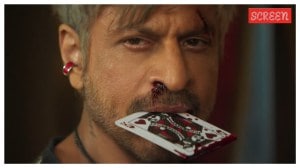Click here to join Express Pune WhatsApp channel and get a curated list of our stories
For Viksit Bharat, per capita income must rise to $20k: Tata Autocomp chairman
Arvind Goel outlined India’s vision of becoming a developed nation by 2045 (Viksit Bharat) and stressed the need for substantial economic growth. Alongside the required per capita income, he also stated that GDP needs to grow from $3.7 trillion to $30 trillion.
 Alongside the required per capita income, he also stated that GDP needs to grow from $3.7 trillion to $30 trillion. (Express Photo)
Alongside the required per capita income, he also stated that GDP needs to grow from $3.7 trillion to $30 trillion. (Express Photo)The current per capita income of India is around $2,400 and if India wants to be Viksit Bharat by 2045, as targeted under the Atma Nirbhar Bharat initiative, then the per capita income should increase to $20,000, said Arvind Goel, chairman of the CII WR Task Force while speaking on future mobility. He emphasised this need while addressing the Confederation of Indian Industry (CII) at the NexGen Mobility exhibition, which began on Friday at the Pune International Exhibition and Convention Centre, focusing on futuristic transportation solutions.
Goel outlined India’s vision of becoming a developed nation by 2045 (Viksit Bharat) and stressed the need for substantial economic growth. Alongside the required per capita income, he also stated that GDP needs to grow from $3.7 trillion to $30 trillion.
“The auto sector will play a pivotal role in this transformation by meeting the growing aspirations of the population and boosting exports, especially in components,” he said.
While discussing the net-zero carbon emissions goal for India by 2070, Goel mentioned that several companies have announced their own targets, with Tata Group committing to achieve net-zero emissions by 2045.
 Goel outlined India’s vision of becoming a developed nation by 2045 (Viksit Bharat) and stressed the need for substantial economic growth. (Express Photo)
Goel outlined India’s vision of becoming a developed nation by 2045 (Viksit Bharat) and stressed the need for substantial economic growth. (Express Photo)
“Tata Power, Tata Steel, and Tata Motors aim to reach this milestone by 2045. The Indian government expects 30 percent of vehicles to be electric by 2030, with two-wheelers and three-wheelers expected to lead the transition. Passenger vehicles are projected to achieve around 20-25 per cent electrification by 2030,” added Goel, who is also the chairman of Tata AutoComp Systems Ltd.
When asked about the different concerns of users related to the use of electric vehicles, Goel said that it depends on how users are using or misusing them, and OEMs (Original Equipment Manufacturers) must also continuously improve the quality of their EVs.
“Ultimately, OEMs test their vehicles. However, issues arise when users tamper with them. It’s a cycle requiring quality improvement. These incidents temporarily disrupt the market, but we will enhance our standards,” he said.
“It’s a cycle. If expectations were set at X, we’ll surpass them. OEMs must observe how users operate EVs, as they often take shortcuts. People install many accessories that absorb excess power, so OEMs will have to see how owners will abuse them. You have to design the vehicle for a monkey-proof system. They will keep reinventing themselves,” Goel added.
NexGen Mobility Exhibition also showcased startup concepts like e-scooters that will work as a feeder service in Pune’s metro stations, as well as pod taxis for last-mile connectivity.
Click here to join Express Pune WhatsApp channel and get a curated list of our stories








